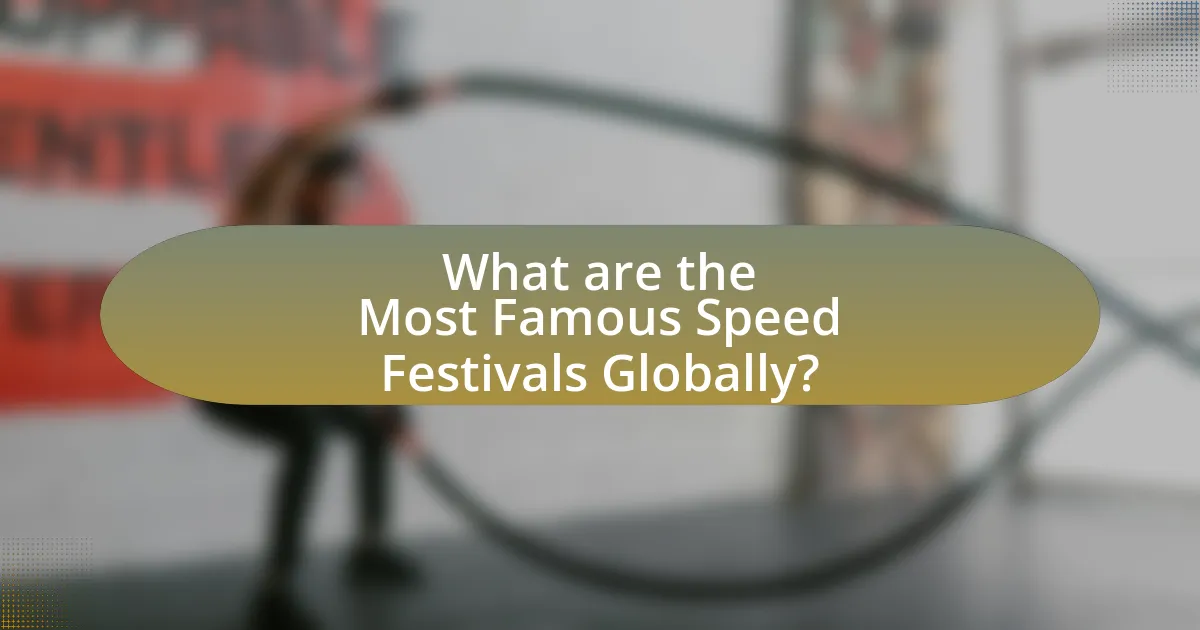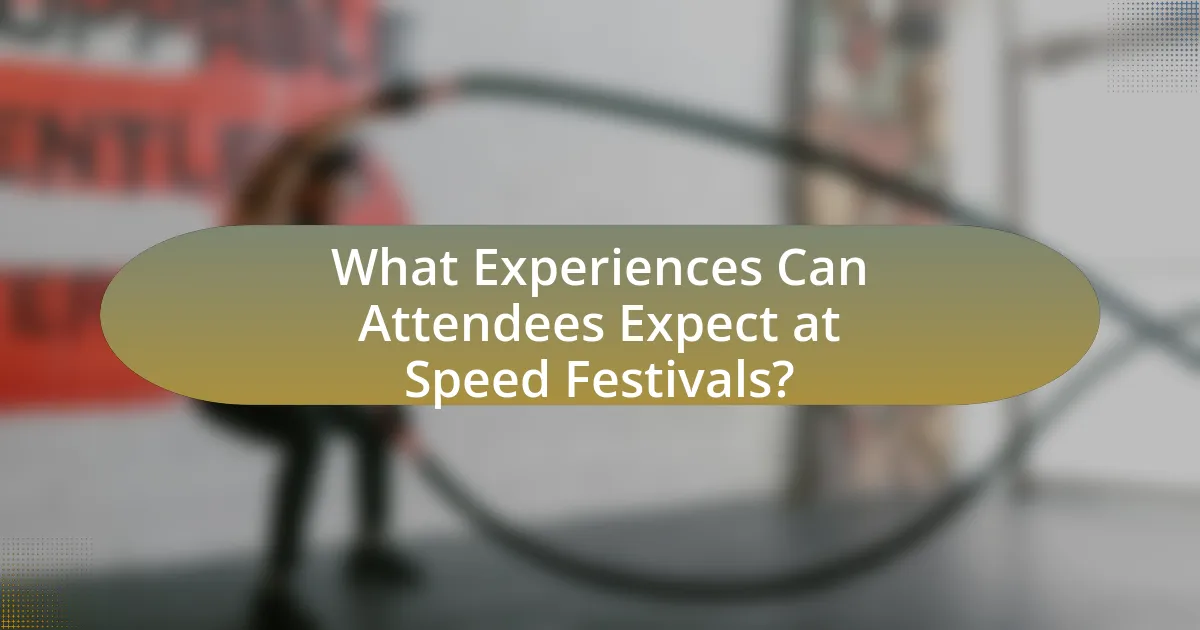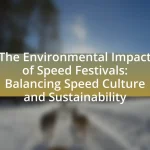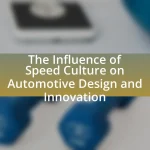The article focuses on iconic speed festivals around the world, highlighting renowned events such as the Monaco Grand Prix, Indianapolis 500, and Goodwood Festival of Speed. It explores how these festivals celebrate automotive culture through competitive racing, vehicle showcases, and community engagement. The piece also examines the diverse types of vehicles featured, regional variations in festival formats, and the historical significance of these events in motorsport. Additionally, it discusses the influence of local cultures, the experiences attendees can expect, and emerging trends shaping the future of speed festivals, including sustainability and technological advancements.
![]()
What are Iconic Speed Festivals Around the World?
Iconic speed festivals around the world include the Monaco Grand Prix, the Indianapolis 500, and the Goodwood Festival of Speed. The Monaco Grand Prix, held annually since 1929, is renowned for its challenging street circuit and glamorous setting. The Indianapolis 500, established in 1911, is one of the oldest and most prestigious automobile races, attracting a massive audience and featuring high-speed oval racing. The Goodwood Festival of Speed, initiated in 1993, celebrates automotive history with a hill climb and showcases a variety of vehicles, from classic cars to modern supercars. Each of these festivals has a rich history and draws significant international attention, making them iconic in the realm of motorsports.
How do speed festivals celebrate automotive culture?
Speed festivals celebrate automotive culture by showcasing high-performance vehicles, promoting motorsport heritage, and fostering community engagement among car enthusiasts. These events feature competitive racing, exhibitions of classic and modern cars, and opportunities for fans to interact with automotive brands and industry professionals. For instance, events like the Goodwood Festival of Speed in the UK highlight the evolution of automotive engineering and design through timed hill climbs and demonstrations, attracting over 200,000 visitors annually. Such festivals not only honor the history and innovation of the automotive industry but also create a vibrant atmosphere where enthusiasts can share their passion for cars.
What types of vehicles are featured in these festivals?
Speed festivals around the world feature a diverse range of vehicles, including classic cars, modern supercars, motorcycles, and vintage racing vehicles. These festivals celebrate automotive history and innovation, showcasing iconic models such as the Ford Mustang, Ferrari F40, and various motorcycle brands like Harley-Davidson. Events like the Goodwood Festival of Speed in the UK highlight both historical and contemporary vehicles, emphasizing their performance and design. The presence of these vehicles at such festivals underscores their significance in automotive culture and the passion of enthusiasts who attend.
How do speed festivals vary by region?
Speed festivals vary by region in terms of cultural significance, types of vehicles featured, and event formats. For instance, in Europe, events like the Goodwood Festival of Speed emphasize classic and vintage cars, showcasing automotive history, while in North America, events such as the Pikes Peak International Hill Climb focus on modern racing technology and extreme conditions. Additionally, regions like Japan celebrate drift culture at events like the D1 Grand Prix, highlighting a unique motorsport style. These regional differences reflect local automotive traditions, climate conditions, and audience preferences, making each festival distinct in its offerings and experiences.
Why are speed festivals significant in motorsport history?
Speed festivals are significant in motorsport history because they celebrate the culture of speed and innovation in automotive engineering. These events, such as the Goodwood Festival of Speed, showcase a diverse range of vehicles, from classic cars to modern supercars, highlighting advancements in technology and design. Historically, speed festivals have served as platforms for manufacturers to unveil new models and for drivers to demonstrate their skills, contributing to the evolution of motorsport. For example, the Goodwood Festival of Speed, established in 1993, has become a key event in the motorsport calendar, attracting over 200,000 visitors annually and featuring iconic vehicles and legendary drivers, thus solidifying its role in promoting the heritage and future of motorsport.
What historical events have shaped the evolution of speed festivals?
The evolution of speed festivals has been shaped by several key historical events, including the introduction of motor racing in the early 20th century, the establishment of the Mille Miglia in 1927, and the rise of Formula One in the 1950s. The early motor racing events, such as the Paris-Bordeaux-Paris race in 1895, showcased the capabilities of automobiles and laid the groundwork for organized speed competitions. The Mille Miglia, a historic endurance race in Italy, became a symbol of automotive excellence and innovation, influencing the format of future speed festivals. Additionally, the formation of Formula One in 1950 revolutionized motorsport, leading to the creation of numerous speed festivals worldwide that celebrate speed, technology, and competition. These events have collectively contributed to the popularity and evolution of speed festivals as we know them today.
How do speed festivals influence modern motorsport trends?
Speed festivals significantly influence modern motorsport trends by showcasing innovative technologies and attracting diverse audiences. These events serve as platforms for manufacturers to debut cutting-edge vehicles and performance enhancements, which often set the stage for future racing developments. For instance, the Goodwood Festival of Speed highlights advancements in electric and hybrid technologies, reflecting the industry’s shift towards sustainability. Additionally, the diverse range of vehicles and formats presented at speed festivals encourages broader participation and interest in motorsport, leading to increased viewership and engagement across various demographics. This trend is supported by statistics indicating that events like the Goodwood Festival attract over 200,000 attendees annually, demonstrating their impact on popularizing motorsport culture.

What are the Most Famous Speed Festivals Globally?
The most famous speed festivals globally include the Goodwood Festival of Speed in the UK, the Pikes Peak International Hill Climb in the USA, and the Isle of Man TT. The Goodwood Festival of Speed, held annually since 1993, showcases a diverse range of motorsport vehicles and attracts over 200,000 visitors. The Pikes Peak International Hill Climb, known as “The Race to the Clouds,” has been held since 1916 and features a challenging 12.42-mile course with 156 turns, drawing top drivers from around the world. The Isle of Man TT, established in 1907, is one of the oldest motorcycle races, renowned for its challenging road course and high speeds, attracting thousands of spectators each year.
Which speed festivals are considered the most iconic?
The most iconic speed festivals include the Bonneville Speed Week, the Isle of Man TT, and the Pikes Peak International Hill Climb. Bonneville Speed Week, held in Utah, is renowned for its land speed records, with vehicles reaching speeds over 600 mph. The Isle of Man TT, a motorcycle race, has been held since 1907 and is famous for its challenging course and high-speed competition, attracting top riders globally. The Pikes Peak International Hill Climb, known as “The Race to the Clouds,” features a 12.42-mile course with 156 turns, where competitors race to the summit of Pikes Peak, showcasing both speed and skill. These festivals are celebrated for their historical significance and the extreme challenges they present to participants.
What unique features distinguish each iconic speed festival?
Each iconic speed festival is distinguished by unique features that reflect its cultural and historical significance. For instance, the Goodwood Festival of Speed in the UK is renowned for its hill climb, where a diverse array of vehicles, from classic cars to modern supercars, race up a 1.16-mile course, showcasing automotive history and innovation. The Monaco Grand Prix, a prestigious Formula 1 race, is characterized by its challenging street circuit that winds through the city, offering a glamorous backdrop and a rich history dating back to 1929. The Pikes Peak International Hill Climb in Colorado is unique for its high-altitude ascent, covering 12.42 miles with 156 turns, testing both driver skill and vehicle performance in extreme conditions. Each festival not only celebrates speed but also emphasizes distinct elements such as location, vehicle diversity, and historical context, making them iconic in the motorsport world.
How do these festivals attract international participants?
Festivals attract international participants through strategic marketing, unique experiences, and cultural significance. These events often utilize social media campaigns, partnerships with travel agencies, and targeted advertisements to reach global audiences. For instance, the Goodwood Festival of Speed in the UK promotes its diverse lineup of motorsport activities and celebrity appearances, drawing enthusiasts from various countries. Additionally, festivals often feature local cuisine, music, and cultural performances, enhancing their appeal. The combination of these factors creates a compelling reason for international attendees to participate, as evidenced by the significant increase in visitor numbers reported at major speed festivals over the years.
What role do local cultures play in speed festivals?
Local cultures significantly shape the character and experience of speed festivals by influencing traditions, practices, and community engagement. For instance, in events like the Isle of Man TT, local customs and historical significance enhance the festival’s appeal, drawing participants and spectators who appreciate the cultural heritage intertwined with high-speed motorcycle racing. Additionally, local cuisines, music, and art often accompany these festivals, creating a unique atmosphere that reflects the region’s identity. This cultural integration not only enriches the festival experience but also fosters community pride and economic benefits through tourism, as seen in events like the Goodwood Festival of Speed, where British automotive culture is celebrated alongside local craftsmanship and innovation.
How do local traditions influence the events at speed festivals?
Local traditions significantly shape the events at speed festivals by incorporating cultural practices, rituals, and community values into the festival activities. For instance, in the Isle of Man TT, local customs such as the remembrance of past racers and the celebration of the island’s heritage enhance the festival atmosphere, creating a unique blend of speed and tradition. Additionally, in events like the Goodwood Festival of Speed, traditional British motorsport culture is celebrated through classic car displays and historical racing, reflecting the local passion for automotive history. These traditions not only attract participants and spectators but also foster a sense of community and identity, making the festivals more meaningful and engaging.
What cultural exchanges occur during these festivals?
Cultural exchanges during speed festivals include the sharing of traditional music, dance, and culinary practices among diverse communities. For example, at the Monaco Grand Prix, attendees experience a blend of French and Monegasque culture through local cuisine and performances, fostering cross-cultural interactions. Similarly, the Indianapolis 500 showcases American racing culture while attracting international participants, leading to the exchange of automotive technology and racing strategies. These interactions not only enhance the festival experience but also promote global understanding and appreciation of different cultural heritages.

What Experiences Can Attendees Expect at Speed Festivals?
Attendees at speed festivals can expect a thrilling combination of high-speed racing, interactive exhibits, and live entertainment. These events typically feature various motorsport competitions, including car and motorcycle races, showcasing both professional and amateur talent. Additionally, attendees often have the opportunity to engage with automotive technology through hands-on experiences, such as simulators and workshops. Many speed festivals also include live music performances and food vendors, enhancing the overall atmosphere and providing a festive environment. The excitement of witnessing high-performance vehicles in action, coupled with the vibrant social scene, makes speed festivals a unique experience for motorsport enthusiasts.
What activities are typically available for festival-goers?
Festival-goers typically engage in activities such as live music performances, food and beverage tastings, and interactive exhibits. These activities are designed to enhance the overall experience of the festival, providing entertainment and cultural engagement. For instance, many speed festivals feature live racing events, showcasing high-speed vehicles and thrilling competitions, which attract large crowds and create an exhilarating atmosphere. Additionally, food vendors often offer local and international cuisine, allowing attendees to sample diverse culinary delights. Interactive exhibits may include opportunities for attendees to learn about automotive technology or participate in hands-on activities related to speed and racing.
How do interactive experiences enhance the festival atmosphere?
Interactive experiences enhance the festival atmosphere by actively engaging attendees, fostering a sense of community and participation. These experiences, such as hands-on activities, live demonstrations, and immersive installations, create memorable moments that encourage social interaction among festival-goers. Research indicates that festivals incorporating interactive elements see increased attendee satisfaction and longer dwell times, as participants are more likely to explore and connect with both the event and each other. For instance, a study by the University of Southern California found that festivals with interactive components reported a 30% increase in positive attendee feedback compared to traditional formats.
What are the best practices for enjoying a speed festival?
To enjoy a speed festival, attendees should prioritize safety, plan their visit in advance, and engage with the event’s activities. Safety is paramount; wearing appropriate gear, following event guidelines, and being aware of surroundings can prevent accidents. Planning involves researching the festival schedule, knowing the location, and arriving early to secure good viewing spots. Engaging with activities, such as participating in fan zones or workshops, enhances the experience. These practices ensure a memorable and enjoyable time at speed festivals, which often attract large crowds and feature high-speed events like racing and stunt shows.
How can attendees prepare for a speed festival?
Attendees can prepare for a speed festival by researching the event schedule, understanding the types of vehicles and races featured, and ensuring they have appropriate gear for weather conditions. Familiarizing oneself with the festival layout and planning transportation in advance enhances the experience. Additionally, attendees should consider purchasing tickets early, as many speed festivals sell out quickly, and reviewing safety guidelines is essential for a safe visit.
What essential items should attendees bring to a speed festival?
Attendees should bring sunscreen, ear protection, comfortable clothing, and hydration supplies to a speed festival. Sunscreen protects against sunburn during outdoor events, while ear protection is crucial due to high noise levels from vehicles. Comfortable clothing allows for ease of movement and enjoyment, and hydration supplies, such as water bottles, are essential to stay hydrated throughout the day. These items enhance the overall experience and ensure safety and comfort at speed festivals.
How can attendees ensure a safe and enjoyable experience?
Attendees can ensure a safe and enjoyable experience by adhering to event guidelines and prioritizing personal safety. Following the specific rules set by festival organizers, such as wearing appropriate safety gear and respecting designated areas, minimizes risks. Additionally, staying hydrated and taking breaks can enhance enjoyment and prevent fatigue. Statistics show that events with clear safety protocols report fewer incidents, reinforcing the importance of compliance for overall well-being.
What are the future trends in speed festivals?
Future trends in speed festivals include the integration of advanced technology, sustainability initiatives, and enhanced spectator experiences. The use of augmented reality and virtual reality is expected to grow, allowing attendees to engage with events in immersive ways. Additionally, many festivals are adopting eco-friendly practices, such as electric vehicle races and carbon offset programs, reflecting a global shift towards sustainability. According to a report by the International Motor Sports Association, events that prioritize environmental responsibility are likely to attract a younger audience, which is crucial for the future of speed festivals.
How is technology shaping the future of speed festivals?
Technology is significantly shaping the future of speed festivals by enhancing participant experiences and improving event logistics. Innovations such as real-time data analytics allow organizers to monitor race conditions and participant performance, leading to more efficient event management. For instance, the integration of augmented reality (AR) and virtual reality (VR) technologies provides immersive experiences for spectators, allowing them to engage with the event in novel ways. Additionally, advancements in drone technology enable aerial coverage and live streaming, expanding the reach of these festivals to global audiences. According to a report by the International Association of Event Hosts, the use of technology in events has increased audience engagement by up to 30%, demonstrating its impact on the future of speed festivals.
What emerging themes are becoming popular in speed festivals?
Emerging themes in speed festivals include sustainability, technological innovation, and inclusivity. Sustainability is gaining traction as festivals adopt eco-friendly practices, such as using renewable energy sources and promoting zero-waste initiatives. Technological innovation is evident through the integration of advanced automotive technologies, including electric vehicles and autonomous driving demonstrations, which enhance the festival experience. Inclusivity is becoming a focal point as organizers strive to create accessible environments for diverse audiences, ensuring that all participants can engage in the festivities. These themes reflect a broader shift towards responsible and forward-thinking practices within the speed festival landscape.

